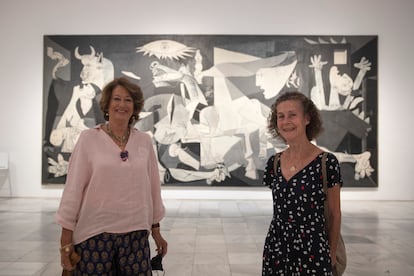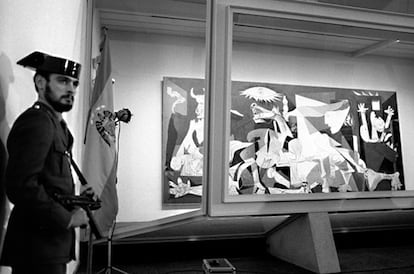The flight attendants who accompanied Picasso’s ‘Guernica’ back from exile
Forty years ago today, Iberia cabin crew Isabel Almazán and Beatriz Ganuza were working on the plane that returned the painting from New York to Madrid. They recount their memories of the experience to EL PAÍS


Flight attendant Isabel Almazán was 38 years old on that day, and she insists that she noticed that there was some kind of fuss when she boarded the plane in New York. But perhaps it’s an invented memory, created once all the events of that day became known. The plane, a Boeing 747 belonging to the then-Spanish flag carrier Iberia, took off from New York’s JFK airport with a slight delay, at 8.20pm. In many respects, it was a normal flight – just another for the IB-952 route. But at around 8am Madrid time, when the plane was already on the tarmac and headed to its gate, Captain Juan López Durán broke the news.
Isabel Almazán and one of her colleagues on that flight, Beatriz Ganuza, quoted the captain’s words yesterday, speaking to EL PAÍS in a café in Madrid. They’ve never forgotten them. “Ladies and gentlemen, I inform you that today you have been traveling with a very special companion: Guernica, which has returned to Spain today and was also on the plane.” Neither of the flight attendants had a clue – nor did most of the passengers.
At that moment, the last exile from the Spanish Civil War had landed in Barajas Airport
After the initial shock, everyone, including the two women, broke into emotional applause. It was September 10, 1981. The Spanish dictator Francisco Franco had died six years before, and Picasso’s most famous painting – one that was loaded with the symbolism of Spain’s recent history – was returning to its home country in the hold of an airplane, rolled up and stuffed into a giant cylinder weighing hundreds of kilos.
For the previous 44 years, it had been on display at New York’s Museum of Modern Art (MoMA), patiently waiting there until Spain met the conditions that Picasso had set for its return: public freedoms for Spaniards. For some time now, Spain’s new democracy had met this condition, but the reticence of the painter’s family and MoMA’s foot-dragging delayed its arrival.
That sunny, warm morning 40 years ago was destined to be historical, because at that moment, the last exile from the Spanish Civil War had landed in Barajas Airport.
Also on the flight were the people ultimately responsible for its return. The culture minister at the time, Íñigo Cavero; the then-director of Fine Arts, historian Javier Tusell; and the deputy director of Visual Arts, Álvaro Martínez-Novillo. As the latter explained in a feature article published in this newspaper in 2016, there were a number of plain-clothes policemen dotted around the plane. Conveniently dressed like spies from a movie, complete with long raincoats, they were in charge of safeguarding the painting and reacting should there be any unexpected events. There were none. Everything went smoothly. In fact, the flight attendants don’t even remember seeing them.

“Maybe we served Coca-Cola to the police-spies, who knows,” one of them explains. “But the truth is I really don’t remember. Everything was completely normal until we landed.”
The minister and the top-ranking officials must have traveled in what was then called Grand Class, the flight attendants assume. This section was located on a second floor and was where the seats could turn into beds at nighttime, after passengers had changed into the “really cute” Burgundy-colored pyjamas that the airline offered these exclusive passengers.
After the announcement by the captain, Isabel Almazán could see from the window of the plane that a real commotion was taking place at the stand where the aircraft was due to come to a stop. There were high-ranking officials, law-enforcement officers, dozens of journalists, television crews and civil guards in shirtsleeves and wearing their distinctive tricornio hats. “That was when I became aware of the importance of what we were carrying,” she explains. “For a joke, I said to a colleague, ‘Not even Ava Gardner would be received like this!’”
It was no wonder there was such a welcoming committee. The government of then-prime minister Adolfo Suárez had treated the issue as a priority case, one that would be another step – by no means the last – to closing the chapter of Spain’s transition to democracy after decades of dictatorship. That was why, Martínez-Novillo explained five years ago, the Spanish government had even threatened the MoMA with legal action should they fail to return the painting before October 25, which was the date of Picasso’s centenary.
The painting – which was conceived by the most famous 20th-century Spanish artist after he found out about the bombing of the Basque town of Gernika by the German Condor Legion during the Civil War – would finally, as was its right, be hung in a museum in the new Spain.
The two flight attendants already knew the painting. They had seen it in New York on a previous trip there. Both began to fly in the middle of the 1960s and enjoyed a great era to work as cabin crew, with good salaries and paid-for accommodation – including expenses – for two or three days before taking the return trip.

Initially, the painting was installed in the Casón del Buen Retiro, an annex of the Prado Museum complex in Madrid. There is an iconic photo of the painting where it appears behind bullet-proof glass, and is being protected by an armed civil guard. In 1992, it was moved to the Reina Sofía museum and finally it was put on display without its protective glass.
In order to be closer to her family, flight attendant Beatriz Ganuza retired at the age of 55, benefiting from a perk of her airline. Elena Almazán, who was more of a traveller and something of a non-conformist, continued to fly until Iberia forced her to retire. She still has the handbag and stylish uniform she used to wear in the 1960s in her house. Both of the women are now aged 78, and yesterday, they made an emotional visit to the painting that flew with them in the hold of that Boeing 747 four decades ago.
When she left the museum, and got on the elevator, Beatriz Ganuza calculated the days and the time difference between Spain and the east coast of the United States. Later, with a tone of surprise and incredulity in her voice, she said to herself out loud: “This time 40 years ago I was having breakfast in New York!”
English version by Simon Hunter.
Tu suscripción se está usando en otro dispositivo
¿Quieres añadir otro usuario a tu suscripción?
Si continúas leyendo en este dispositivo, no se podrá leer en el otro.
FlechaTu suscripción se está usando en otro dispositivo y solo puedes acceder a EL PAÍS desde un dispositivo a la vez.
Si quieres compartir tu cuenta, cambia tu suscripción a la modalidad Premium, así podrás añadir otro usuario. Cada uno accederá con su propia cuenta de email, lo que os permitirá personalizar vuestra experiencia en EL PAÍS.
¿Tienes una suscripción de empresa? Accede aquí para contratar más cuentas.
En el caso de no saber quién está usando tu cuenta, te recomendamos cambiar tu contraseña aquí.
Si decides continuar compartiendo tu cuenta, este mensaje se mostrará en tu dispositivo y en el de la otra persona que está usando tu cuenta de forma indefinida, afectando a tu experiencia de lectura. Puedes consultar aquí los términos y condiciones de la suscripción digital.
More information
Últimas noticias
Most viewed
- David King, chemist: ‘There are scientists studying how to cool the planet; nobody should stop these experiments from happening’
- Reinhard Genzel, Nobel laureate in physics: ‘One-minute videos will never give you the truth’
- Oona Chaplin: ‘I told James Cameron that I was living in a treehouse and starting a permaculture project with a friend’
- Mexico completes its trade shift with the entry into force of tariffs on China and countries without trade agreements
- Sinaloa Cartel war is taking its toll on Los Chapitos









































